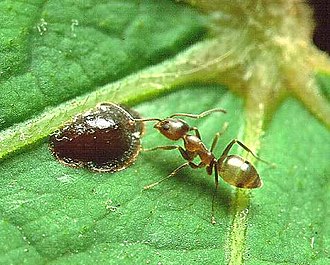Argentine ant

The Argentine ant (Linepithema humile), formerly Iridomyrmex humilis, is an ant native to northern Argentina, Uruguay, Paraguay, Bolivia and southern Brazil. It is an invasive species that has been established in many Mediterranean climate areas,[1] inadvertently introduced by humans to many places, including South Africa, New Zealand, Japan, Easter Island, Australia, Europe, Hawaii, and the continental United States.[2][3]
The worker ants are 1.6–2.8 millimetres (0.06–0.11 in) long[4][5][dubious – discuss] and can easily squeeze through cracks and holes as small as 1 millimetre (0.04 in) in size. Queens are 4.2–6.4 millimetres (0.17–0.25 in) long,[4] much smaller than other species of ants. These ants will set up quarters in the ground, in cracks in concrete walls, in spaces between boards and timbers, even among belongings in human dwellings. In natural areas, they generally nest shallowly in loose leaf litter or beneath small stones, due to their poor ability to dig deeper nests. However, if a deeper nesting ant species abandons their nest, Argentine ant colonies will readily take over the space.[citation needed]
The native range of Argentine ants is limited to around major waterways in the lowland areas of the Paraná River drainage. They have recently spread into parts of Argentina, Brazil, Chile, Colombia, Ecuador, and Peru.[6] The species has become established in at least 15 countries throughout the world, on six continents, as well as many oceanic islands.[7]
According to research published in Insectes Sociaux in 2009, it was discovered that ants from three Argentine ant supercolonies in America, Europe, and Japan, that were previously thought to be separate, were in fact most likely to be genetically related. The three colonies in question were one in Europe, stretching 6,000 km (3,700 mi) along the Mediterranean coast, the “Californian large” colony, stretching 900 km (560 mi) along the coast of California, and a third on the west coast of Japan.[8][9]
Based on a similarity in the chemical profile of hydrocarbons on the cuticles of the ants from each colony, and on the ants’ non-aggressive and grooming behaviour when interacting, compared to their behaviour when mixing with ants from other super-colonies from the coast of Catalonia in Spain and from Kobe in Japan, researchers concluded that the three colonies studied actually represented a single global super-colony.[8][9]
The researchers stated that the “enormous extent of this population is paralleled only by human society”, and had probably been spread and maintained by human travel.[8][9]
